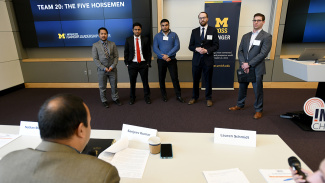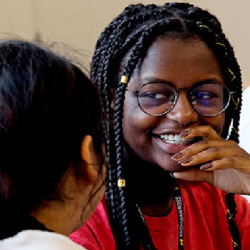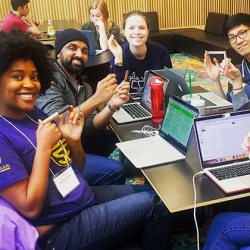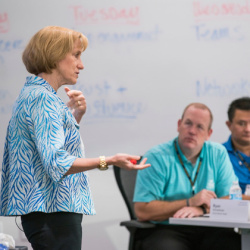It Was Day One of Our MBA And We Dove Head-First Into Impact

Incoming first-year Weekend MBA students recently had the chance to partner with Amazon on a top-secret project as part of the Business + Impact Challenge, powered by the Sanger Leadership Center.
The two-day event, which took place in May, asked students to develop and present solutions to a real, relevant business challenge faced by Amazon.
While the Business + Impact Challenge is designed to throw new MBAs head-first into an impact-oriented challenge and deliver solutions for the partner company, it’s also an opportunity for learning and networking for the first-year students. Working in small teams, students are guided through numerous leadership and team trainings before meeting with content experts who provide rich detail on the landscape of the business challenge.
Then, teams create a solution alongside an Amazon employee mentor, and pitch their ideas to a team of judges. Three teams are invited to compete in a final round, which is judged by Michigan Ross faculty, alumni, and Amazon employees.
This year’s winning team was made up of five Weekend MBAs with a range of experience from the financial sector to engineering. We caught up with the team to learn what made them successful, and what they are looking forward to as they embark on the first-year of their MBA.
What did you find most rewarding about the Business + Impact Challenge?
Nate Robertstad: Our entire cohort is made up of accomplished and highly motivated individuals. It’s going to be tough to get to know everyone in the next two years. Learning and collaborating with this group and knowing what we could do in the short amount of time was amazing. I know that I will fall back on this group of people in the future, regardless of where we end up.
What did you find most difficult about the Business + Impact Challenge?
Nate: The time crunch accelerated the normal process of forming a team and understanding how we all fit together. We all are used to doing things different ways based on our experiences. We worked through it together very well but the hardest part was adjusting to the Amazon culture for the scope and scale regarding our idea and the PR/FAQ. It took awhile for us to really embrace that. But once we did, we knew we had something special to present.
How did your Amazonian mentor help you during the challenge?
Nate: I think each of us were used to our company's culture for problem solving and idea generation. Breaking some of those habits and shifting to the Amazon way was really tough. She really helped us understand the Amazon culture and really focus on working backwards from the customer.
Let’s talk about your team dynamic. How did you organize initially to work together?
Nate: When we had our list of sessions, a couple of us started putting our names down and we all started falling in line to volunteer for other things. We naturally found things we wanted to do and that made some of our team roles come through. As we moved from session to session, we noted things on our white board and others would add things. This helped us progress through the challenge.
What strengths did each person bring to the table?
Nate: Henry had a lot of tech knowledge regarding Amazon and was always bringing the financial process of each idea to the table. Kamal and Pritish had a lot of specific knowledge about the challenge topicand could really speak to the viability of the solutions we had. Louie kept us focused on big picture solutions that would be easily integrated with Amazon’s capabilities.
Did you have any hurdles or points of tension you had to work through?
Nate: Like every other team, there was a point where we had to shift from idea generation to generating results. This meant picking a solution and running with it. At this point, we had decided to narrow down our solutions to three and then put it to a vote. The pain point was that one person was very invested in their idea and really pushed for it. But after the vote, we went with a different solution. That person didn’t complain or make things difficult. In fact, they did the complete opposite and ran with the new solution.
What is the biggest learning take-away you had after completing the challenge?
Louie Wallis: I felt the biggest learning take-away is that when you’re faced with a time-sensitive team project, it is important to have a structured process in place that keeps the team on track. Through our feedback from the judges and after talking with members of other teams, it sounded like what our team really excelled at was developing a strong game plan as to how we should attack the challenge, and sticking to that game plan throughout the challenge. Our early deliverables presented an organized team structure and process. While there were frustrations when we tried to pinpoint a single idea to run with during the idea generation process, we stuck to our plan and made sure we voted on our ultimate solution by a certain cutoff time, which gave us plenty of time on the backend to construct the details of the proposal.
What advice would you give to other incoming MBAs who will participate in the Business + Impact Challenge?
Kamal Dhiman: The advice that I’d give to the incoming class is to reflect within themselves to how they fit into the Michigan Model of Leadership and how they can leverage the newly gained knowledge to build more effective teams. The Sanger staff had armed us with some powerful techniques about team building and leadership before we were presented with the Business + Impact Challenge. Also, it is highly advised to make use of guest/faculty lectures and other resources that Ross has to offer. Lastly, but most importantly, do not lose sight of the big picture.
As you know, Business + Impact is an integral part of Ross as we seek to build a better world through business. In which ways do you plan to create impact while at Ross, in your current role, and beyond?
Louie: Earlier in my career I worked for a firm that specializes in impact investing, using a double bottom-line approach to bring strong financial returns to investors and impactful social benefits to the communities in which it invests. That experience opened my eyes to the fact that private enterprise can play a major role in solving some of the U.S.’s biggest community challenges.
The Business + Impact Challenge reiterated this point to me, but more on a global basis. My current employer is a Small Business Investment Company (“SBIC”), which is a federally licensed private investment firm that has the mandate of investing capital into small and medium sized businesses in the U.S. to foster growth in that segment of the economy. During my time at Ross I hope to have the opportunity to get involved in some of the Business + Impact programs and attend events in the Social Innovation Series. In my career, I hope I can continue to work in a capacity that creates both economic and social value.
After completing the challenge and meeting some of your classmates, what are you most excited for during your Ross MBA?
Nate: With 120 people in our class, it’s really hard to get to know everyone in the first weekend. But we have an opportunity to work in different groups during our two years. This challenge really brought the five of us together. We tackled the challenge together and created great relationships from it. And I’m looking forward to having a similar experience with other groups and individuals over the next two years.
The Business + Impact Challenge takes place at the start of both the Weekend and Full-Time MBA programs at Michigan Ross. The next challenge will be on August 6-8, 2019, for the Full-Time MBA Class of 2021.







